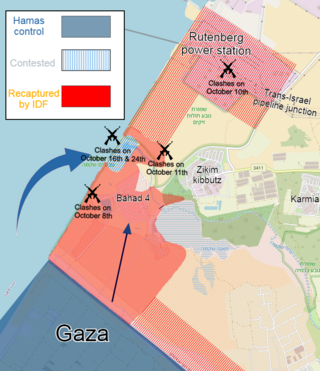This page is a partial listing of incidents of violence in the Israeli-Palestinian conflict in 2004.
In 2004, the Israeli Defense Forces launched Operation "Days of Penitence", otherwise known as Operation "Days of Repentance" in the northern Gaza Strip. The operation lasted between 29 September and 16 October 2004. About 130 Palestinians, and 1 Israeli were killed.
This page is a partial listing of incidents of violence in the Israeli-Palestinian conflict in 2005.

The Izz ad-Din al-Qassam Brigades, named after Izz ad-Din al-Qassam, is the military wing of the Palestinian organization Hamas. Currently led by Mohammed Deif, IQB is the largest and best-equipped militant group operating within Gaza today.

The 2006 Gaza–Israel conflict, known in Israel as Operation Summer Rains, was a series of battles between Palestinian militants and the Israel Defense Forces (IDF) during summer 2006, prompted by the capture of Israeli soldier Gilad Shalit by Palestinian militants on 25 June 2006. Large-scale conventional warfare occurred in the Gaza Strip, starting on 28 June 2006, which was the first major ground operation in the Gaza Strip since Israel's unilateral disengagement plan was implemented between August and September 2005.
This is the Timeline of the Israeli–Palestinian conflict in 2007.

In 2008, Israel sought to halt the rocket and mortar fire from Gaza that killed four Israeli civilians that year and caused widespread trauma and disruption of life in Israeli towns and villages close to the Gaza border. In addition, Israel insisted that any deal include an end to Hamas's military buildup in Gaza, and movement toward the release of Corporal Gilad Shalit. Hamas wanted an end to the frequent Israeli military strikes and incursions into Gaza, and an easing of the economic blockade that Israel has imposed since Hamas took over the area in 2007.

The Gaza War, also known as Operation Cast Lead, also known as the Gaza Massacre, and referred to as the Battle of al-Furqan by Hamas, was a three-week armed conflict between Gaza Strip Palestinian paramilitary groups and the Israel Defense Forces (IDF) that began on 27 December 2008 and ended on 18 January 2009 with a unilateral ceasefire. The conflict resulted in 1,166–1,417 Palestinian and 13 Israeli deaths. Over 46,000 homes were destroyed in Gaza, making more than 100,000 people homeless.
Events in the year 2006 in Israel.

The 2006 Gaza cross-border raid was an armed incursion carried out by seven or eight Gazan Palestinian militants on 25 June 2006 who attacked Israel Defense Forces (IDF) positions near the Kerem Shalom Crossing through an attack tunnel. In the attack, two IDF soldiers and two Palestinian militants were killed, four IDF soldiers were wounded, one of whom was Gilad Shalit, who was captured and taken to the Gaza Strip.
The 2004 IDF outpost bombing attack was an integrated attack carried out on 12 December 2004 by a Palestinian militant squad of the Izz al-Din al-Qassam military wing of Hamas and the Fatah Hawks at an Israel Defense Forces outpost located on the border between the Gaza Strip and Egypt.
The following is a timeline of the 2014 Gaza War. Over 2014, Palestinians suffered the highest number of civilian casualties since the Six-Day War in 1967, according to a United Nations report, given the July–August conflict, and rising tolls in the West Bank and East Jerusalem. A spike in Israeli casualties also occurred. 2,256 Palestinians and 85 Israelis died, while 17,125 Palestinians, and 2,639 Israelis suffered injuries.

A vast network of tunnels used for smuggling and warfare purposes exists under the Gaza Strip. The underground tunnel network allows Hamas and other militant groups to store and shield weapons, gather and move underground, communicate, train, launch offensive attacks, transport hostages, and retreat without being detected by Israeli or Egyptian authorities. This network of tunnels is colloquially referred to as the Gaza metro. According to Tehran IRGC General, there are more than 500 kilometers of tunnels.

As part of the 7 October 2023 attack on Israel from the Gaza Strip, a military engagement took place near Zikim, Israel between Hamas militants and the Israel Defense Forces (IDF). According to Haaretz, Hamas's goal was to capture Zikim's military training base. The Israeli navy prevented most Hamas militants from landing on the beach, although an estimated 11 militants landed. Fighting took place outside Zikim, at three military bases, and on the adjacent coastline. The garrison of the training base held out, but the other two bases were overrun, and a civilian security team prevented an incursion into the kibbutz. An estimated 19 civilian beachgoers were killed.

The Nahal Oz attack was an assault on the kibbutz of Nahal Oz and the adjacent military base near the northern Gaza Strip on the morning of 7 October 2023 as part of a 2023 Hamas-led attack on Israel. In the attack, more than 60 Israeli soldiers and more than a dozen kibbutz residents were killed. Some soldiers and residents were kidnapped and taken to the Gaza Strip.

The siege of Gaza City began on 2 November 2023, when the Israel Defense Forces (IDF) surrounded Gaza City, amid the Israeli invasion of the Gaza Strip, which was a counterattack to the 2023 Hamas-led attack on Israel. Gaza City is the most populated city in the Gaza Strip and the battle started on 30 October 2023, when Israel and Hamas clashed in Gaza City. According to Oxfam, there are about 500,000 Palestinians, along with 200 Israelis and other captives, currently trapped in a "siege within a siege" in northern Gaza.








